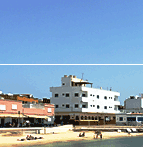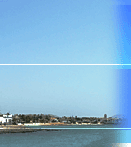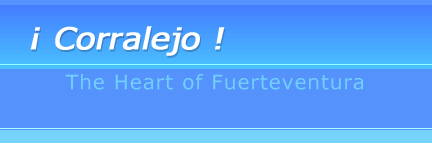Corralejo Dunes 2025: Discover Fuerteventura's Desert Paradise
🌊 Essential Beach Information: For comprehensive details about all Corralejo beaches and coastal attractions, explore our Complete Corralejo Beach Guide 2025 featuring the best beaches, facilities, and water activities.
The Corralejo Dunes Natural Park stands as one of Fuerteventura's most spectacular attractions, offering visitors an otherworldly landscape of shifting white sand dunes that stretch for miles along the northern coast. This protected natural wonderland creates a unique desert-meets-ocean environment found nowhere else in Europe.
🏆 Corralejo Dunes Highlights 2025
- Natural Protection: UNESCO-recognized natural park covering 2,668 hectares
- Unique Landscape: Massive white sand dunes created by Saharan winds
- Pristine Beaches: 11km of untouched coastline with crystal-clear waters
- Photography Paradise: Endless opportunities for stunning landscape photography
- Free Access: Open 24/7 with no entrance fees
- Wildlife Watching: Home to unique flora and fauna adapted to desert conditions
🌵 About Corralejo Dunes Natural Park
Established as a protected natural area in 1994, the Corralejo Dunes Natural Park represents one of the Canary Islands' most important ecological treasures. The park encompasses both the spectacular inland dunes and the coastal area known as Grandes Playas (Big Beaches), creating a diverse ecosystem that supports rare plant species and provides critical nesting areas for seabirds.
Formation and Geology
The Corralejo dunes were formed over thousands of years through a remarkable natural process. Saharan winds carry fine sand particles across the Atlantic Ocean, depositing them on Fuerteventura's northern shores. The constant trade winds then sculpt and reshape these deposits, creating the ever-changing landscape visitors see today.
Key Geological Features:
- Living Dunes: Constantly shifting formations that change with wind patterns
- Stabilized Areas: Older dunes anchored by specialized vegetation
- Volcanic Backdrop: Ancient volcanic cones provide dramatic contrast
- Coastal Interface: Unique meeting point between desert and ocean environments
📸 Best Photography Spots & Viewing Areas
Golden Hour Magic (Sunrise & Sunset)
The Corralejo dunes transform into a photographer's dream during golden hour, when the angled sunlight creates dramatic shadows and highlights across the sand formations.
📷 Pro Photography Tips for Corralejo Dunes
- Best Times: 6:30-8:00 AM (sunrise) and 6:00-7:30 PM (sunset)
- Optimal Positions: Climb higher dunes for expansive landscape shots
- Equipment Tips: UV filter essential, lens cloth for sand protection
- Composition Ideas: Use volcanic peaks as backdrop, capture wind patterns in sand
- Portrait Photography: Soft, even lighting perfect for dramatic portraits
- Weather Considerations: Clear days offer best contrast, cloudy days create moody atmosphere
Iconic Viewpoints
Dune Summit Panoramas
Location: Central high dunes, approximately 1km from main access points
Features: 360-degree views encompassing the entire dune field, ocean vistas, and distant volcanic landscapes. The climb takes 15-20 minutes but rewards visitors with unparalleled photo opportunities.
Coastal Edge Photography
Location: Where dunes meet the beach along Grandes Playas
Features: Dramatic contrast between white sand formations and turquoise Atlantic waters. Perfect for capturing the unique transition from desert to ocean environment.
Volcanic Contrast Points
Location: Southern edge near Montaña Roja (Red Mountain)
Features: Striking juxtaposition of white sand dunes against red volcanic rock formations, creating some of the most dramatic landscape compositions on the island.
🚶♂️ Walking Trails & Exploration Routes
Easy Access Trails (Suitable for All Ages)
Coastal Walk Route
Distance: 3-5km (customizable)
Duration: 1-2 hours
Difficulty: Easy
Description: Follow the coastline along Grandes Playas, experiencing the transition from beach to dunes. This route offers stunning ocean views and is perfect for families with children.
Dune Edge Circuit
Distance: 2-3km loop
Duration: 45-90 minutes
Difficulty: Easy to Moderate
Description: Explore the perimeter of the dune field without venturing into the challenging deep sand areas. Excellent for photography and wildlife observation.
Moderate Hiking Routes
Central Dune Traverse
Distance: 4-6km
Duration: 2-3 hours
Difficulty: Moderate
Description: Cross through the heart of the dune field, climbing several major formations. This route requires good fitness due to walking in deep sand but offers the most authentic desert experience.
Volcanic Viewpoint Trek
Distance: 5-7km
Duration: 2.5-3.5 hours
Difficulty: Moderate to Challenging
Description: Combine dune exploration with volcanic landscape viewing, including climbs to strategic viewpoints that showcase the geological diversity of the area.
⚠️ Essential Safety & Preparation Tips
- Sun Protection: High-SPF sunscreen, hat, and sunglasses absolutely essential
- Hydration: Carry 1-2 liters of water per person for longer walks
- Footwear: Lightweight hiking shoes or closed sandals; avoid flip-flops
- Time Planning: Avoid midday heat (11 AM - 3 PM) during summer months
- Navigation: Stay oriented using visible landmarks; GPS recommended for longer treks
- Wind Awareness: Strong winds can create sandstorms; check weather conditions
- Group Safety: Never explore alone; inform others of your planned route
🌿 Wildlife & Natural Environment
Unique Flora Adaptations
The Corralejo dunes support a remarkable collection of plant species specially adapted to the harsh desert conditions. These hardy plants play a crucial role in stabilizing sand formations and providing habitat for local wildlife.
Notable Plant Species:
- Sea Rocket (Cakile maritima): Purple-flowered pioneer species that colonizes new sand areas
- Canarian Spurge (Euphorbia paralias): Succulent endemic to the Canary Islands
- Sand Couch Grass (Elymus farctus): Hardy grass that helps bind sand dunes
- Prickly Saltwort (Salsola kali): Spiny shrub adapted to high salt conditions
- Sea Lavender (Limonium pectinatum): Endemic species with delicate purple flowers
Birdlife and Fauna
The protected status of the Corralejo dunes provides sanctuary for numerous bird species, making it an excellent destination for wildlife enthusiasts and birdwatchers.
Common Bird Species:
- Cream-coloured Courser: Rare desert bird that breeds in the dunes
- Houbara Bustard: Large ground bird, critically endangered
- Kentish Plover: Small shorebird that nests in coastal areas
- Barbary Partridge: Endemic game bird adapted to arid conditions
- Spectacled Warbler: Migratory songbird common during breeding season
🚗 Access & Getting There
By Car (Recommended)
Driving provides the most flexibility for exploring different sections of the Corralejo dunes. Multiple access points allow visitors to choose locations based on their interests and fitness levels.
Main Access Points:
- Northern Entrance: FV-1 highway, 3km south of Corralejo town center
- Central Access: Dirt road from FV-1, leads to largest dune formations
- Southern Access: Near El Cotillo road junction, less crowded
- Beach Access: Grandes Playas entrance for coastal exploration
Parking Information: Free parking available at all access points. Arrive early during peak season (November-April) to secure spots near preferred entrances.
Public Transportation
Bus Route 6: Corralejo to Puerto del Rosario stops near the northern access point. Ask the driver for "Dunas de Corralejo" stop. Service runs every 30-60 minutes depending on season.
Walking from Corralejo: 30-45 minute walk from Corralejo town center to the nearest dune access point. Pleasant coastal route suitable for most fitness levels.
Guided Tours & Transportation
Several local companies offer specialized dune tours, particularly valuable for photography enthusiasts and those seeking expert knowledge about the ecosystem.
- Photography Tours: Led by local photographers familiar with best spots and lighting conditions
- Eco Tours: Focus on flora, fauna, and conservation efforts within the natural park
- Sunset Tours: Timed visits for optimal lighting and fewer crowds
- 4WD Excursions: Access to remote areas not reachable on foot
🏖️ Nearby Attractions & Activities
Grandes Playas (Big Beaches)
The eastern boundary of the dunes opens onto some of Fuerteventura's most beautiful beaches. These pristine stretches of white sand offer excellent swimming, sunbathing, and water sports opportunities.
Beach Features:
- Length: 11km of continuous coastline
- Sand Quality: Fine white sand, consistently clean and well-maintained
- Water Conditions: Generally calm, suitable for swimming and snorkeling
- Facilities: Limited facilities preserve natural character
- Activities: Swimming, snorkeling, windsurfing, kitesurfing, fishing
Lobos Island Excursions
From the Corralejo dunes area, visitors can easily access ferry services to Lobos Island, a small volcanic islet offering additional hiking opportunities and pristine snorkeling locations.
Water Sports Centers
The consistent wind conditions that shape the dunes also create excellent conditions for wind-powered water sports along the adjacent coastline.
- Windsurfing Schools: Several centers offer lessons and equipment rental
- Kitesurfing Areas: Designated zones for safe kitesurfing practice
- Stand-up Paddleboarding: Calmer areas suitable for SUP exploration
- Snorkeling Sites: Rocky areas near dune boundaries offer marine life viewing
📅 Best Times to Visit
Seasonal Considerations
Winter (December - February)
Advantages: Mild temperatures perfect for hiking, excellent photography conditions, fewer crowds
Considerations: Occasional rainfall, stronger winds, shorter daylight hours
Recommended For: Serious hikers, photographers, nature enthusiasts
Spring (March - May)
Advantages: Perfect weather conditions, wildflower blooms, optimal visibility
Considerations: Increasing tourist numbers, higher accommodation costs
Recommended For: All visitors, particularly families and casual hikers
Summer (June - August)
Advantages: Long daylight hours, warm ocean temperatures, consistent weather
Considerations: Intense heat during midday, crowded conditions, limited early morning/evening access recommended
Recommended For: Beach lovers, early risers, sunset enthusiasts
Autumn (September - November)
Advantages: Warm but comfortable temperatures, excellent sea conditions, fewer crowds than summer
Considerations: Occasional weather changes, variable wind conditions
Recommended For: Photography, extended hiking, water sports
Daily Timing Recommendations
- Early Morning (6:00-9:00 AM): Cool temperatures, soft lighting, minimal crowds
- Late Afternoon/Evening (5:00-7:30 PM): Comfortable conditions, spectacular sunsets
- Avoid: Midday hours (11:00 AM-3:00 PM) during summer months due to intense heat
🎯 Planning Your Perfect Dunes Visit
Half-Day Visit (3-4 hours): Focus on one main area, include coastal walk and photography
Full-Day Adventure (6-8 hours): Combine multiple access points, include beach time and extended hiking
Multi-Day Exploration: Different times of day for varied lighting, combine with other Corralejo attractions
🏨 Accommodation Near Corralejo Dunes
For convenient access to the dunes and related attractions, consider staying in Corralejo town center or nearby beachfront properties. Our comprehensive accommodation guide provides detailed information about hotels, apartments, and vacation rentals that offer easy access to the natural park.
Recommended Areas:
- Corralejo Town Center: Walking distance to dunes, restaurants, and shops
- Grandes Playas Area: Beachfront properties with direct dune access
- El Cotillo: Quieter alternative with scenic coastal access to southern dunes
The Corralejo Dunes Natural Park represents one of Fuerteventura's crown jewels, offering visitors a rare opportunity to experience a true desert environment within a pristine coastal setting. Whether you're seeking spectacular photography opportunities, peaceful nature walks, or simply the wonder of exploring a unique landscape, the dunes provide an unforgettable experience that showcases the remarkable natural diversity of the Canary Islands.
For additional information about exploring Corralejo and Fuerteventura, visit our guides to island activities, beach destinations, and optimal travel timing.









